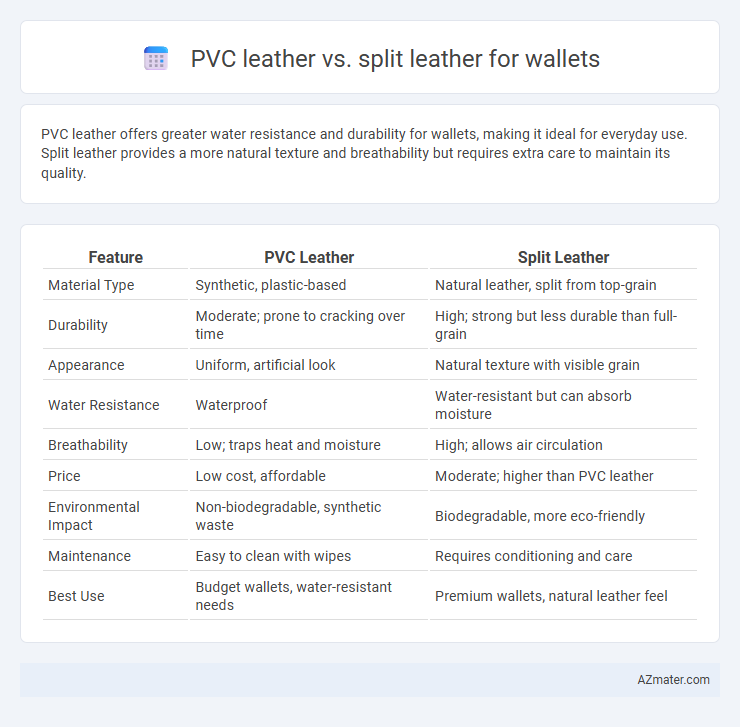PVC leather offers greater water resistance and durability for wallets, making it ideal for everyday use. Split leather provides a more natural texture and breathability but requires extra care to maintain its quality.
Table of Comparison
| Feature | PVC Leather | Split Leather |
|---|---|---|
| Material Type | Synthetic, plastic-based | Natural leather, split from top-grain |
| Durability | Moderate; prone to cracking over time | High; strong but less durable than full-grain |
| Appearance | Uniform, artificial look | Natural texture with visible grain |
| Water Resistance | Waterproof | Water-resistant but can absorb moisture |
| Breathability | Low; traps heat and moisture | High; allows air circulation |
| Price | Low cost, affordable | Moderate; higher than PVC leather |
| Environmental Impact | Non-biodegradable, synthetic waste | Biodegradable, more eco-friendly |
| Maintenance | Easy to clean with wipes | Requires conditioning and care |
| Best Use | Budget wallets, water-resistant needs | Premium wallets, natural leather feel |
Introduction to Wallet Materials
PVC leather, a synthetic material made from polyvinyl chloride, offers durability, water resistance, and affordability, making it a popular choice for budget-friendly wallets. Split leather is derived from the fibrous lower layers of a hide, providing a genuine leather feel with a textured surface but generally less durability than full-grain leather. Wallets made from PVC leather often appeal to consumers seeking easy maintenance, while split leather wallets attract those valuing natural leather aesthetics at a lower cost.
What is PVC Leather?
PVC leather, also known as synthetic or faux leather, is made from a plastic polymer called polyvinyl chloride coated on fabric, offering durability and water resistance ideal for wallets. Split leather, derived from the lower layers of animal hide, provides a more natural texture but is less durable and less resistant to moisture compared to PVC leather. For wallets, PVC leather delivers cost-effective, easy-to-clean, and long-lasting performance, while split leather emphasizes a genuine leather feel with moderate durability.
What is Split Leather?
Split leather is derived from the lower layers of a hide after the top grain is separated, offering a more affordable alternative to full-grain leather. Unlike PVC leather, which is synthetic and made from polyvinyl chloride, split leather retains genuine animal hide qualities but often requires a surface coating for durability and appearance. Wallets crafted from split leather combine natural texture with cost-effectiveness, while PVC leather provides water resistance and easy maintenance without the breathability of real leather.
Durability Comparison: PVC Leather vs Split Leather
PVC leather offers superior water resistance and retains its appearance longer under daily wear, making it more durable against scratches and stains compared to split leather. Split leather, derived from the lower layers of hide, tends to be less durable because it lacks the dense fibrous texture of top-grain leather, leading to quicker wear and potential cracking over time. For wallets, PVC leather's synthetic composition resists moisture and abrasion, ensuring longer-lasting performance in harsh or wet conditions.
Aesthetic Differences
PVC leather for wallets offers a smooth, uniform surface with vibrant colors and a polished finish, giving it a sleek and modern aesthetic. Split leather showcases natural grain patterns, a textured feel, and a rustic charm that develops character over time due to its fibrous structure. The aesthetic appeal of PVC leather leans towards consistent, glossy looks, while split leather provides a more organic, vintage appearance favored in artisanal designs.
Cost and Affordability
PVC leather wallet offers superior affordability due to its synthetic nature, making it a cost-effective choice for budget-conscious consumers. Split leather, derived from the fibrous part of the hide beneath the top grain, is more expensive because of its natural material quality and durability. Consumers seeking wallets with a premium feel often invest more in split leather, while PVC leather suits those prioritizing low cost and ease of maintenance.
Environmental Impact
PVC leather, a synthetic material derived from polyvinyl chloride, poses significant environmental concerns due to its production process that releases harmful dioxins and difficulty in biodegradation. Split leather, a byproduct of genuine leather, has a lower environmental footprint compared to PVC, as it repurposes animal hides that would otherwise be discarded, though it still involves resource-intensive tanning processes. Choosing split leather over PVC leather for wallets reduces reliance on fossil-fuel-based plastics and promotes waste valorization, but mindful sourcing and processing remain critical for minimizing overall ecological impact.
Maintenance and Care
PVC leather wallets require minimal maintenance, needing only occasional wiping with a damp cloth to remove dirt and prevent cracking. Split leather wallets demand more intensive care, including regular conditioning with leather treatments to maintain suppleness and avoid drying or flaking. Proper maintenance extends the lifespan of split leather, while PVC offers greater durability with less effort.
Which Is Better for Wallets?
PVC leather offers superior durability, water resistance, and affordability, making it a practical choice for wallets that require long-lasting wear and easy maintenance. Split leather, derived from the lower layers of animal hide, provides a more natural texture and breathability but tends to be less durable and more prone to moisture damage than full-grain leather. For wallets, PVC leather is generally better due to its resilience and cost-effectiveness, especially in high-use scenarios where longevity is essential.
Final Verdict: Choosing the Right Leather
PVC leather offers durability, water resistance, and affordability, making it a practical choice for budget-conscious buyers looking for low-maintenance wallets. Split leather, derived from the fibrous part of the hide, provides a more natural leather feel and improved breathability but may lack the longevity and water resistance of full-grain or top-grain options. Selecting the right leather wallet depends on prioritizing factors like cost, durability, and aesthetic preferences, where PVC suits synthetic durability seekers and split leather appeals to those desiring genuine leather texture at a moderate price.

Infographic: PVC leather vs Split leather for Wallet
 azmater.com
azmater.com